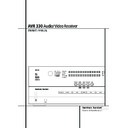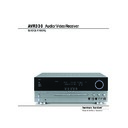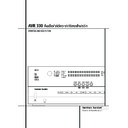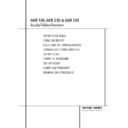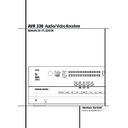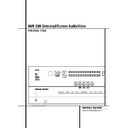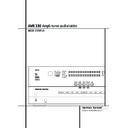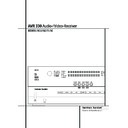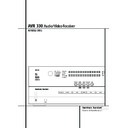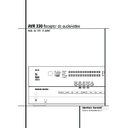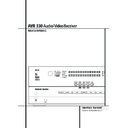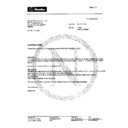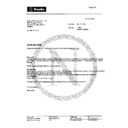Harman Kardon AVR 330 (serv.man2) User Manual / Operation Manual ▷ View online
INTRODUCTION 3
Introduction
Thank you for choosing Harman Kardon!
With the purchase of a Harman Kardon
AVR 330 you are about to begin many years of
listening enjoyment. Designed to provide all the
excitement and detail of movie soundtracks and
every nuance of musical selections, the AVR 330
is truly a multichannel receiver for the new mil-
lennium. In addition to the traditional 5.1 digital
decoding modes such as Dolby Digital and DTS,
it offers the latest advancements in surround
technology such as Dolby Pro Logic II, the full
suite of DTS-ES 6.1 modes, DTS Neo:6 and the
latest 7.1 channel versions of Harman's own
Logic 7 technology.
With the purchase of a Harman Kardon
AVR 330 you are about to begin many years of
listening enjoyment. Designed to provide all the
excitement and detail of movie soundtracks and
every nuance of musical selections, the AVR 330
is truly a multichannel receiver for the new mil-
lennium. In addition to the traditional 5.1 digital
decoding modes such as Dolby Digital and DTS,
it offers the latest advancements in surround
technology such as Dolby Pro Logic II, the full
suite of DTS-ES 6.1 modes, DTS Neo:6 and the
latest 7.1 channel versions of Harman's own
Logic 7 technology.
The AVR 330 has been engineered so that it is
easy to take advantage of all the power of its
digital technology. On-screen menus, fully color
coded connection jacks and terminals and our
exclusive EzSet
easy to take advantage of all the power of its
digital technology. On-screen menus, fully color
coded connection jacks and terminals and our
exclusive EzSet
™
remote make installation fast
and simple. However, to obtain the maximum
enjoyment from your new receiver, we urge you
to read this manual. A few minutes spent learn-
ing the functions of the various controls will
enable you to take advantage of all the power
the AVR 330 is able to deliver.
enjoyment from your new receiver, we urge you
to read this manual. A few minutes spent learn-
ing the functions of the various controls will
enable you to take advantage of all the power
the AVR 330 is able to deliver.
If you have any questions about this product, its
installation or its operation, please contact your
retailer or custom installer. They are your best
local sources of information.
installation or its operation, please contact your
retailer or custom installer. They are your best
local sources of information.
Description and Features
The AVR 330 is among the most versatile and
multifeatured A/V receivers available, incorporat-
ing a wide range of listening options. In addition
to Dolby Digital and DTS decoding for digital
sources, a broad choice of surround modes for
Matrix surround-encoded or Stereo recordings
are available for use with sources such as CD,
VCR, TV broadcasts and the AVR 330’s own
FM/AM tuner. Along with Dolby Digital EX, Dolby
Pro Logic II, DTS Neo:6, Dolby 3 Stereo, 5
Channel or 7 Channel Stereo and Hall and
Theater modes, the AVR 330 offers Harman
International’s exclusive Logic 7 process in both
5.1 and 7.1 versions to create a wider, more
enveloping field environment and more defined
fly-overs and pans. Another Harman Kardon
exclusive is VMAx, which uses proprietary pro-
cessing to create an open, spacious sound field
even when only two front speakers are available.
The AVR 330 is among the most versatile and
multifeatured A/V receivers available, incorporat-
ing a wide range of listening options. In addition
to Dolby Digital and DTS decoding for digital
sources, a broad choice of surround modes for
Matrix surround-encoded or Stereo recordings
are available for use with sources such as CD,
VCR, TV broadcasts and the AVR 330’s own
FM/AM tuner. Along with Dolby Digital EX, Dolby
Pro Logic II, DTS Neo:6, Dolby 3 Stereo, 5
Channel or 7 Channel Stereo and Hall and
Theater modes, the AVR 330 offers Harman
International’s exclusive Logic 7 process in both
5.1 and 7.1 versions to create a wider, more
enveloping field environment and more defined
fly-overs and pans. Another Harman Kardon
exclusive is VMAx, which uses proprietary pro-
cessing to create an open, spacious sound field
even when only two front speakers are available.
In addition to providing a wide range of listening
options, the AVR is easy to configure so that it
provides the best results with your speakers and
specific listening-room environment.
options, the AVR is easy to configure so that it
provides the best results with your speakers and
specific listening-room environment.
A Stereo-Direct mode bypasses the digital
processor to preserve all of the subtleties of
older analog, two-channel materials, while bass
management, available in the surround and
Stereo-Digital modes,improves your ability to
tailor the sound to suit your room acoustics or
taste.
processor to preserve all of the subtleties of
older analog, two-channel materials, while bass
management, available in the surround and
Stereo-Digital modes,improves your ability to
tailor the sound to suit your room acoustics or
taste.
On-screen menus make it simple to enter set-
tings for speaker configurations and bass man-
agement, and the EzSet remote measures a sys-
tem’s sound levels and automatically calibrates
them for perfectly balanced sound field presen-
tation.
tings for speaker configurations and bass man-
agement, and the EzSet remote measures a sys-
tem’s sound levels and automatically calibrates
them for perfectly balanced sound field presen-
tation.
For the ultimate in flexibility, the AVR features
connections for five video devices, all with both
composite and S-Video inputs. Two additional
audio inputs are available, and a total of six digi-
tal inputs and three outputs make the AVR 330
capable of handling all the latest digital audio
sources.
For compatibility with the latest HDTV video
sources and progressive scan DVD players, the
AVR also features wide-bandwidth,
low-crosstalk component video switching.
connections for five video devices, all with both
composite and S-Video inputs. Two additional
audio inputs are available, and a total of six digi-
tal inputs and three outputs make the AVR 330
capable of handling all the latest digital audio
sources.
For compatibility with the latest HDTV video
sources and progressive scan DVD players, the
AVR also features wide-bandwidth,
low-crosstalk component video switching.
Coax and optical digital outputs are available for
direct connection to digital recorders. Two video
recording outputs, preamp-out and a color-
coded eight-channel input make the AVR 330
virtually future-proof, with everything needed to
accommodate tomorrow’s new formats right on
board.
direct connection to digital recorders. Two video
recording outputs, preamp-out and a color-
coded eight-channel input make the AVR 330
virtually future-proof, with everything needed to
accommodate tomorrow’s new formats right on
board.
The AVR 330 flexibility and power extend
beyond your main home theater or listening
room. The AVR includes a sophisticated multi-
zone control system that allows you to select
one source for use in the main room and a dif-
ferent one (Audio only) in a second room.
Complete control over volume is possible with a
separate infrared control link. To make it easy to
operate the AVR 330 from a remote room, a
separate “Zone II” remote is included. Additional
multiroom options include the option to assign
two of the AVR’s output channels to the multi-
room system.
beyond your main home theater or listening
room. The AVR includes a sophisticated multi-
zone control system that allows you to select
one source for use in the main room and a dif-
ferent one (Audio only) in a second room.
Complete control over volume is possible with a
separate infrared control link. To make it easy to
operate the AVR 330 from a remote room, a
separate “Zone II” remote is included. Additional
multiroom options include the option to assign
two of the AVR’s output channels to the multi-
room system.
The AVR 330’s powerful amplifier uses
traditional Harman Kardon high-current design
technologies to meet the wide dynamic range of
any program selection.
traditional Harman Kardon high-current design
technologies to meet the wide dynamic range of
any program selection.
Harman Kardon invented the high-fidelity
receiver more then fifty years ago. With state-of-
the-art circuitry and time-honored circuit designs,
the AVR 330 is the perfect combination of the
latest in digital audio technology, a quiet yet
powerful analog amplifier in an elegant,
easy-to-use package.
receiver more then fifty years ago. With state-of-
the-art circuitry and time-honored circuit designs,
the AVR 330 is the perfect combination of the
latest in digital audio technology, a quiet yet
powerful analog amplifier in an elegant,
easy-to-use package.
■ Dolby* Digital, Dolby Digital EX and
Dolby Pro Logic* II Decoding, and the
full suite of DTS
full suite of DTS
®
modes, including
DTS-ES
®
6.1 Discrete & Matrix and
Neo:6
®
■ Seven channels of high-current amplifi-
cation with two channels assignable to
either surround back or multiroom
applications
either surround back or multiroom
applications
■ Harman Kardon’s exclusive Logic 7
®
processing, available for the first time
with both 7.1 and 5.1 processing in
a variety of modes and two modes
of VMAx
with both 7.1 and 5.1 processing in
a variety of modes and two modes
of VMAx
®
■ Stereo-Direct Mode for Two-Channel
Sources Bypasses DSP Processing to
Preserve the Integrity of Analog
Materials
Preserve the Integrity of Analog
Materials
■ Stereo-Digital Mode for Programmable
Bass Management of Low Frequencies
Between Main Speakers and
Subwoofer
Between Main Speakers and
Subwoofer
■
remote automatically sets
output levels for optimum performance
■ High-bandwidth, HDTV-compatible
component video switching
■ Front panel analog A/V inputs
■ Front panel digital inputs for easy con-
■ Front panel digital inputs for easy con-
nection to portable digital devices and
the latest video game consoles
the latest video game consoles
■ Multiple digital inputs and outputs
■ On-screen menu and display system
■ Extensive multiroom options including
■ On-screen menu and display system
■ Extensive multiroom options including
a standard Zone II remote and assignable
amplifier channels
amplifier channels
■ 6-Channel/8-Channel Direct Input and
Preamp Outputs for Easy Expansion and
Use with Future Audio Formats
Use with Future Audio Formats
■ Extensive bass management options,
including three separate crossover
groupings
groupings
■ Main Remote with Internal Codes
TM
4 SAFETY INFORMATION
Safety Information
Important Safety Information
Verify Line Voltage Before Use
Your AVR has been designed for use with 220-
240-Volt AC current. Connection to a line
voltage other than that for which it is intended
can create a safety and fire hazard and may
damage the unit.
Your AVR has been designed for use with 220-
240-Volt AC current. Connection to a line
voltage other than that for which it is intended
can create a safety and fire hazard and may
damage the unit.
If you have any questions about the voltage
requirements for your specific model, or about
the line voltage in your area, contact your dealer
before plugging the unit into a wall outlet.
requirements for your specific model, or about
the line voltage in your area, contact your dealer
before plugging the unit into a wall outlet.
Do Not Use Extension Cords
To avoid safety hazards, use only the power cord
attached to your unit. We do not recommend
that extension cords be used with this product.
As with all electrical devices, do not run power
cords under rugs or carpets or place heavy
objects on them. Damaged power cords should
be replaced immediately by an authorized
service depot with a cord meeting factory
specifications.
To avoid safety hazards, use only the power cord
attached to your unit. We do not recommend
that extension cords be used with this product.
As with all electrical devices, do not run power
cords under rugs or carpets or place heavy
objects on them. Damaged power cords should
be replaced immediately by an authorized
service depot with a cord meeting factory
specifications.
Handle the AC Power Cord Gently
When disconnecting the power cord from an AC
outlet, always pull the plug, never pull the cord.
If you do not intend to use the unit for any
considerable length of time, disconnect the plug
from the AC outlet.
When disconnecting the power cord from an AC
outlet, always pull the plug, never pull the cord.
If you do not intend to use the unit for any
considerable length of time, disconnect the plug
from the AC outlet.
Do Not Open the Cabinet
There are no user-serviceable components inside
this product. Opening the cabinet may present a
shock hazard, and any modification to the
product will void your guarantee. If water or any
metal object such as a paper clip, wire or a
staple accidentally falls inside the unit,
disconnect it from the AC power source
immediately, and consult an authorized service
station.
There are no user-serviceable components inside
this product. Opening the cabinet may present a
shock hazard, and any modification to the
product will void your guarantee. If water or any
metal object such as a paper clip, wire or a
staple accidentally falls inside the unit,
disconnect it from the AC power source
immediately, and consult an authorized service
station.
Installation Location
■ To assure proper operation and to avoid the
■ To assure proper operation and to avoid the
potential for safety hazards, place the unit on
a firm and level surface. When placing the
unit on a shelf, be certain that the shelf and
any mounting hardware can support the
weight of the product.
a firm and level surface. When placing the
unit on a shelf, be certain that the shelf and
any mounting hardware can support the
weight of the product.
■ Make certain that proper space is provided
both above and below the unit for ventilation.
If this product will be installed in a cabinet or
other enclosed area, make certain that there
is sufficient air movement within the cabinet.
Under some circumstances a fan may be
required.
If this product will be installed in a cabinet or
other enclosed area, make certain that there
is sufficient air movement within the cabinet.
Under some circumstances a fan may be
required.
■ Do not place the unit directly on a carpeted
surface.
■ Avoid installation in extremely hot or cold
locations, or an area that is exposed to direct
sunlight or heating equipment.
sunlight or heating equipment.
■ Avoid moist or humid locations.
■ Do not obstruct the ventilation slots on the
■ Do not obstruct the ventilation slots on the
top of the unit, or place objects directly over
them.
them.
Cleaning
When the unit gets dirty, wipe it with a clean,
soft, dry cloth. If necessary, wipe it with a soft
cloth dampened with mild soapy water, then a
fresh cloth with clean water. Wipe dry
immediately with a dry cloth. NEVER use
benzene, aerosol cleaners, thinner, alcohol or any
other volatile cleaning agent. Do not use
abrasive cleaners, as they may damage the finish
of metal parts. Avoid spraying insecticide near
the unit.
When the unit gets dirty, wipe it with a clean,
soft, dry cloth. If necessary, wipe it with a soft
cloth dampened with mild soapy water, then a
fresh cloth with clean water. Wipe dry
immediately with a dry cloth. NEVER use
benzene, aerosol cleaners, thinner, alcohol or any
other volatile cleaning agent. Do not use
abrasive cleaners, as they may damage the finish
of metal parts. Avoid spraying insecticide near
the unit.
Moving the Unit
Before moving the unit, be certain to disconnect
any interconnection cords with other
components, and make certain that you
disconnect the unit from the AC outlet.
Before moving the unit, be certain to disconnect
any interconnection cords with other
components, and make certain that you
disconnect the unit from the AC outlet.
Unpacking
The carton and shipping materials used to
protect your new receiver during shipment were
specially designed to cushion it from shock and
vibration. We suggest that you save the carton
and packing materials for use in shipping if you
move, or should the unit ever need repair.
protect your new receiver during shipment were
specially designed to cushion it from shock and
vibration. We suggest that you save the carton
and packing materials for use in shipping if you
move, or should the unit ever need repair.
To minimize the size of the carton in storage,
you may wish to flatten it. This is done by
carefully slitting the tape seams on the bottom
and collapsing the carton. Other cardboard
inserts may be stored in the same manner.
Packing materials that cannot be collapsed
should be saved along with the carton in a
plastic bag.
you may wish to flatten it. This is done by
carefully slitting the tape seams on the bottom
and collapsing the carton. Other cardboard
inserts may be stored in the same manner.
Packing materials that cannot be collapsed
should be saved along with the carton in a
plastic bag.
If you do not wish to save the packaging
materials, please note that the carton and other
sections of the shipping protection are
recyclable. Please respect the environment and
discard those materials at a local recycling
center.
materials, please note that the carton and other
sections of the shipping protection are
recyclable. Please respect the environment and
discard those materials at a local recycling
center.
FRONT PANEL CONTROLS
5
1 Main Power Switch: Press this button to
apply power to the AVR. When the switch is
pressed in, the unit is placed in a Standby
mode, as indicated by the orange LED
apply power to the AVR. When the switch is
pressed in, the unit is placed in a Standby
mode, as indicated by the orange LED
3. This
button MUST be pressed in to operate the unit.
To turn the unit off completely and prevent the
use of the remote control, this switch should be
pressed until it pops out from the front panel so
that the word “OFF” may be read at the top of
the switch.
To turn the unit off completely and prevent the
use of the remote control, this switch should be
pressed until it pops out from the front panel so
that the word “OFF” may be read at the top of
the switch.
NOTE: This switch is normally left in the “ON”
position.
position.
2 System Power Control: When the Main
Power Switch
Power Switch
1 is “ON,” press this button to
turn on the AVR; press it again to turn the unit
off (to Standby). Note that the Power Indicator
3 will turn blue when the unit is on.
off (to Standby). Note that the Power Indicator
3 will turn blue when the unit is on.
3 Power Indicator: This LED will be illuminated
in orange when the unit is in the Standby mode
to signal that the unit is ready to be turned on.
When the unit is in operation, the indicator will
turn blue.
in orange when the unit is in the Standby mode
to signal that the unit is ready to be turned on.
When the unit is in operation, the indicator will
turn blue.
4 Headphone Jack: This jack may be used to
listen to the AVR’s output through a pair of head-
phones. Be certain that the headphones have a
standard 6.3 mm stereo phone plug. Note that
the speakers will automatically be turned off
when the headphones are connected.
listen to the AVR’s output through a pair of head-
phones. Be certain that the headphones have a
standard 6.3 mm stereo phone plug. Note that
the speakers will automatically be turned off
when the headphones are connected.
5 Surround Mode Group Selector: Press
this button to select the top-level group of
surround modes. Each press of the button will
select a major mode grouping in the following
order:
this button to select the top-level group of
surround modes. Each press of the button will
select a major mode grouping in the following
order:
Dolby Modes
➜ DTS Digital Modes ➜ DSP
Modes
➜ Stereo Modes ➜ Logic 7 Modes
Once the button is pressed so that the name of
the desired surround mode group appears in the
Main Information Display
the desired surround mode group appears in the
Main Information Display
˜, press the
Surround Mode Selector
9 to cycle through
the individual modes available. For example, press
this button to select Dolby modes, and then press
the Surround Mode Selector
this button to select Dolby modes, and then press
the Surround Mode Selector
9 to choose
from the various mode options.
6 Speaker Select Button: Press this button
to begin the process of selecting the speaker
positions that are used in your listening room.
(See page 18 for more information on setup and
configuration.)
to begin the process of selecting the speaker
positions that are used in your listening room.
(See page 18 for more information on setup and
configuration.)
Front Panel Controls
1
2
3
4
5
6
7
8
9
)
2
3
4
5
6
7
8
9
)
!
@
#
$
%
^
&
*
(
Ó
@
#
$
%
^
&
*
(
Ó
Ô
Ò
Ú
Û
Ù
ı
ˆ
˜
¯
Ò
Ú
Û
Ù
ı
ˆ
˜
¯
Main Power Switch
System Power Control
Power Indicator
Headphone Jack
Surround Mode Group Selector
Speaker Select Button
Selector Buttons
Tone Mode
Surround Mode Selector
Tuning
System Power Control
Power Indicator
Headphone Jack
Surround Mode Group Selector
Speaker Select Button
Selector Buttons
Tone Mode
Surround Mode Selector
Tuning
Tuner Band Selector
Set Button
Preset Stations Selector
Speaker/Channel Input Indicator
Input Source Selector
RDS Select Button
Delay
Digital Optical 3 Input
Surround Mode Indicators
Digital Coax 3 Input
Set Button
Preset Stations Selector
Speaker/Channel Input Indicator
Input Source Selector
RDS Select Button
Delay
Digital Optical 3 Input
Surround Mode Indicators
Digital Coax 3 Input
Video 4 input jacks
Bass Control
Balance Control
Treble Control
Digital Input Selector
Channel Select Button
Volume Control
Input Indicators
Main Information Display
Remote Sensor Window
Bass Control
Balance Control
Treble Control
Digital Input Selector
Channel Select Button
Volume Control
Input Indicators
Main Information Display
Remote Sensor Window
2
4
8
6
5
)
!
@
%
*
Ô
Ò
1
3
9
7
#
^
Ù
(
˜
ˆ
Û
&
¯
Ú
ı
Ó
7
$
DIGITAL EX
LOGIC 7
VID 1
DVD
CD
FM
TAPE
8 CH
VID 2
VID 3
VID 4
PRO LOGIC
3 STEREO
DSP
7 CH. STEREO
SURR. OFF
SBL
SBR
6
FRONT PANEL CONTROLS
Front Panel Controls
7 Selector Buttons: When you are establishing
the AVR’s configuration settings, use these buttons
to select from the choices available, as shown in
the Main Information Display
the AVR’s configuration settings, use these buttons
to select from the choices available, as shown in
the Main Information Display
˜.
8 Tone Mode: Pressing this button enables or
disables the Balance, Bass and Treble tone
controls. When the button is pressed so that the
words
disables the Balance, Bass and Treble tone
controls. When the button is pressed so that the
words
TONE I N
appear in the Main
Information Display
˜, the settings of the
Bass
and Treble Ú controls and of the
Balance control
Ò will affect the output
signals. When the button is pressed so that the
words
words
TONE OUT
appear in the Main
Information Display
˜, the output signal will
be “flat,” without any balance, bass or treble
alteration.
alteration.
9 Surround Mode Selector: Press this button
to select from among the available surround
mode options for the mode group selected. The
specific modes will vary based on the number of
speakers available, the mode group and if the
input source is digital or analog. For example,
press the Surround Mode Group Selector
to select from among the available surround
mode options for the mode group selected. The
specific modes will vary based on the number of
speakers available, the mode group and if the
input source is digital or analog. For example,
press the Surround Mode Group Selector
5
to select a mode grouping such as Dolby or Logic
7, and then press this button to see the mode
choices available. For more information on mode
selection, see page 30.
7, and then press this button to see the mode
choices available. For more information on mode
selection, see page 30.
) Tuning Selector: Press the left side of the
button to tune lower frequency stations and the
right side of the button to tune higher frequency
stations. When a station with a strong signal is
reached,
button to tune lower frequency stations and the
right side of the button to tune higher frequency
stations. When a station with a strong signal is
reached,
MANUAL TUNED
or
AUTO
TUNED
will appear in the Main Information
Display
˜ (see page 38 for more information
on tuning stations).
! Tuner Band Selector: Pressing this button
will automatically switch the AVR to the Tuner
mode. Pressing it again will switch between the
AM and FM frequency bands, holding it pressed
for some seconds will switch between stereo and
mono receiving and between automatic and
manual tuning mode (See page 38 for more
information on the tuner).
will automatically switch the AVR to the Tuner
mode. Pressing it again will switch between the
AM and FM frequency bands, holding it pressed
for some seconds will switch between stereo and
mono receiving and between automatic and
manual tuning mode (See page 38 for more
information on the tuner).
@ Set Button: When making choices during the
setup and configuration process, press this button
to enter the desired setting as shown in the
Main Information Display
setup and configuration process, press this button
to enter the desired setting as shown in the
Main Information Display
˜ into the AVR’s
memory. The set button may also be used to
change the display brightness. (See page 35.)
change the display brightness. (See page 35.)
# Preset Stations Selector: Press this
button to scroll up or down through the list of
stations that have been entered into the preset
memory. (See page 38 for more information on
tuner programming.)
button to scroll up or down through the list of
stations that have been entered into the preset
memory. (See page 38 for more information on
tuner programming.)
$ Speaker/Channel Input Indicators: These
indicators are multipurpose, indicating either the
speaker type selected for each channel or the
incoming data-signal configuration. The left, center,
right, right surround and left surround speaker
indicators are composed of three boxes, while the
subwoofer is a single box. The center box lights
when a “Small” speaker is selected, and the two
outer boxes light when “Large” speakers are
selected. When none of the boxes are lit for the
center, surround or subwoofer channels, no speaker
has been selected for that position. (See page 19
for more information on configuring speakers.) The
letters inside each of the center boxes display
active input channels. For standard analog inputs,
only the L and R will light, indicating a stereo
input. When a digital source is playing, the indica-
tors will light to display the channels begin
received at the digital input. When the letters
flash, the digital input has been interrupted. (See
page 21 for more information on the Channel
Indicators).
indicators are multipurpose, indicating either the
speaker type selected for each channel or the
incoming data-signal configuration. The left, center,
right, right surround and left surround speaker
indicators are composed of three boxes, while the
subwoofer is a single box. The center box lights
when a “Small” speaker is selected, and the two
outer boxes light when “Large” speakers are
selected. When none of the boxes are lit for the
center, surround or subwoofer channels, no speaker
has been selected for that position. (See page 19
for more information on configuring speakers.) The
letters inside each of the center boxes display
active input channels. For standard analog inputs,
only the L and R will light, indicating a stereo
input. When a digital source is playing, the indica-
tors will light to display the channels begin
received at the digital input. When the letters
flash, the digital input has been interrupted. (See
page 21 for more information on the Channel
Indicators).
% Input Source Selector: Press this button to
change the input by scrolling through the list of
input sources.
change the input by scrolling through the list of
input sources.
^ RDS Select Button: Press this button to
display the various messages that are part of the
RDS data system of the AVR’s tuner.
(See page 39 for more information on RDS).
display the various messages that are part of the
RDS data system of the AVR’s tuner.
(See page 39 for more information on RDS).
& Delay: Press this button to begin the
sequence of steps required to enter delay time
settings. (See page 23 for more information on
delay times.)
sequence of steps required to enter delay time
settings. (See page 23 for more information on
delay times.)
* Digital Optical 3 Input: Connect the optical
digital audio output of an audio or video product
to this jack. When the Input is not in use, be
certain to keep the plastic cap installed to avoid
dust contamination that might degrade future
performance.
digital audio output of an audio or video product
to this jack. When the Input is not in use, be
certain to keep the plastic cap installed to avoid
dust contamination that might degrade future
performance.
( Surround Mode Indicators: The current
selected mode or function will appear as one of
these indicators. Note that when the unit is
turned on, the entire list of available modes will
light briefly, and then revert to normal operation
with only the active mode indicator illuminated.
selected mode or function will appear as one of
these indicators. Note that when the unit is
turned on, the entire list of available modes will
light briefly, and then revert to normal operation
with only the active mode indicator illuminated.
Ó Digital Coax 3 Input: This jack is normally
used for connection to the output of portable
digital audio devices, video game consoles or
other products that have a coax digital jack.
used for connection to the output of portable
digital audio devices, video game consoles or
other products that have a coax digital jack.
Ô Video 4 Input Jacks: These audio/video
jacks may be used for temporary connection to
video games or portable audio/video products
such as camcorders and portable audio players.
jacks may be used for temporary connection to
video games or portable audio/video products
such as camcorders and portable audio players.
Bass Control: Turn this control to modify the
low frequency output of the left/right channels by
as much as ±10dB. Set this control to a suitable
position for your taste or room acoustics.
low frequency output of the left/right channels by
as much as ±10dB. Set this control to a suitable
position for your taste or room acoustics.
Ò Balance Control: Turn this control to
change the relative volume for the front left/right
channels.
change the relative volume for the front left/right
channels.
NOTE: For proper operation of the surround
modes this control should be at the midpoint or
“12 o’clock” position.
modes this control should be at the midpoint or
“12 o’clock” position.
Ú Treble Control: Turn this control to modify
the high frequency output of the left/right channels
by as much as ±10dB. Set this control to a suitable
position for your taste or room acoustics.
the high frequency output of the left/right channels
by as much as ±10dB. Set this control to a suitable
position for your taste or room acoustics.
Û Digital Input Selector: When playing a
source that has a digital output, press this button
to select between the Optical
source that has a digital output, press this button
to select between the Optical
and Coaxial
Digital inputs. (See pages 22-24 for more
information on digital audio.)
information on digital audio.)
Ù Channel Select Button: Press this button
to begin the process of trimming the channel
output levels using an external audio source.
(For more information on output level trim
adjustment, see page 33.)
to begin the process of trimming the channel
output levels using an external audio source.
(For more information on output level trim
adjustment, see page 33.)
ı Volume Control: Turn this knob clockwise
to increase the volume, counterclockwise to
decrease the volume. If the AVR is muted, adjust-
ing volume control will automatically release the
unit from the silenced condition.
to increase the volume, counterclockwise to
decrease the volume. If the AVR is muted, adjust-
ing volume control will automatically release the
unit from the silenced condition.
ˆ Input indicators: The current selected
mode or function will appear as one of these
indicators. Note that when the unit is turned on,
the entire list of available modes will light briefly,
and then revert to normal operation with only
the active mode indicator illuminated.
mode or function will appear as one of these
indicators. Note that when the unit is turned on,
the entire list of available modes will light briefly,
and then revert to normal operation with only
the active mode indicator illuminated.
˜ Main Information Display: This display
delivers messages and status indications to help
you operate the receiver.
delivers messages and status indications to help
you operate the receiver.
¯ Remote Sensor Window: The sensor
behind this window receives infrared signals from
the remote control. Aim the remote at this area
and do not block or cover it unless an external
remote sensor is installed.
behind this window receives infrared signals from
the remote control. Aim the remote at this area
and do not block or cover it unless an external
remote sensor is installed.

